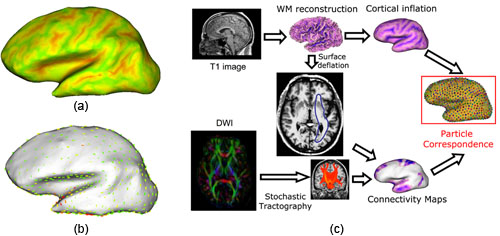Cortical Correspondence Using Entropy-Based Particle Systems and Local Features
Martin Styner
Departments of Computer Science, Psychiatry, University of North Carolina Chapel HillBackground
This project entails a technological collaboration, which also dovetails with the clinical collaboration with the research group of Joe Piven, MD and UNC. This goal of this collaboration is the develop technologies for parameterizing complex surfaces the entropy-based particle system. The driving application has been cortical surface parameterization for group studies on sets of brain images. However, the applications extend beyond this to include orthopedics (complex surfaces assciated with joints, such as the mantibular) and animal phenotyping studies.The strategy is to work with a simplified geometry (Figure 1a) that includes information about sulcal depth. Results, as in Figure 1b, demonstrate that the system is able to find correspondences that reduce the variability of sulcal depth (particle colors depict this) relative to other methods.
 |
Fig 1: a) The inflated cortical surface (from FreeSurfer551) shows a simplified structure but encodes cortical shape with sulcal depth (green=low and red=high). b) A particle system that optimizes for position and cortical depth shows improvements in variability (green=low, red=high). c) A pipeline for cortical correspondence that includes connectivity information from diffusion-weighted images. The inflation step helps place particles on smooths surfaces while accounting for sulcal depth, while the deflation step helps to associate points on the cortex with connectivity information from stochastic tractography. |
A second aspect of this work is to combine cortical geometry with other structural and functional information, such as connectivity, vasculature, and oxygen update (fMRI). The Styner laboratory has developed a pipeline, based on ShapeWorks, for cortical correspondence that includes connectivity information from diffusion weighted images (Figure 1c). The inflation step helps place particles on smooths surfaces while accounting for sulcal depth, and the deflation step helps to associate points on the cortex with connectivity information from stochastic tractography. Preliminary results show that the method improves quality of correspondences across the ensemble.
Members of the Styner laboratory have collaborated closely with the Center. They are active participants in ShapeWorks development, and we have extended the ShapeWorks framework to accommodate their own technical interests and needs. Future collaborations will include further development and evaluation of the system for fusing different data as well as new methods for parameterizing complex surface, such as the approach of geodesic distance.
Publications
- Hong-Kai Zhao, T. Chan, B. Merriman, and S. Osher. "A variational level set approach to multiphase motion. Journal of Computational Physics", 127(1):179–195, 1996.
- I. Oguz, J. Cates, P.T. Fletcher, R. Whitaker, D. Cool, S. Aylward, and M. Styner. "Entropy-based particle systems and local features for cortical correspondence optimization". In Proc. IEEE Int. Sym. on Biomedical Imaging (ISBI '08), pages 1637–1641, 2008.
- I. Oguz, M. Niethammer, J. Cates, R. Whitaker, T. Fletcher, C. Vachet, and M. Styner. "Cortical correspondence with probabilistic fiber connectivity". In Information Process Med Imaging (IPMI 2009), pages 651–63, 2009.
